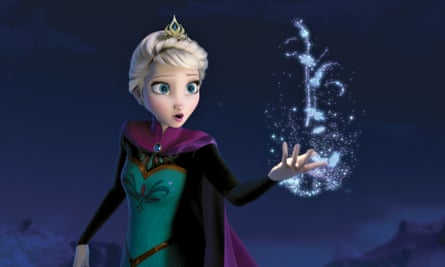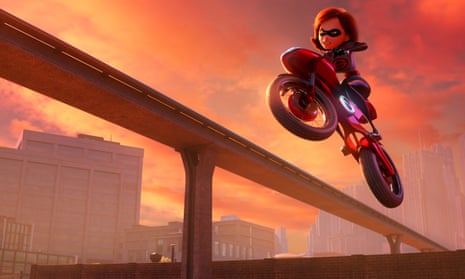Brie Larson is the latest Hollywood actor to call for a greater gender balance in film criticism – yet when the US reviews for Incredibles 2 emerged after its 15 June release, voices were overwhelmingly male. Not only that, but some were so focused on their arousal at Elastigirl’s shapely form, they failed to spot – or at least comment upon – the fact that the film is a feminist triumph.
As a female film critic watching Incredibles 2, I was thrilled to see an animation that bucked tired gender cliches even more than the first film had. The plot that sees Mrs Helen Parr/Elastigirl (voiced by Holly Hunter) going to work while her husband looks after the kids isn’t a simple case of role reversal: it’s an act of sisterhood. When rich benefactor Winston Deavor (Bob Odenkirk) starts a plan to bring back banned superheroes, it’s his tech-savvy sister Evelyn Deavor (Catherine Keener) who crunches the numbers and states that Mrs Incredible is the best person for the world-saving job – she’s statistically less liable to cause havoc and more likely to get results. “Heavyweight problems need heavyweight solutions,” bristles Elastigirl’s bulky husband (Craig T Nelson), unaccustomed to having his status challenged – but, like Winston, he complies.
Numbers are something that the men in suits understand – and that’s why the Geena Davis Institute on Gender and Media has been crunching them in real life, too. For the last 14 years they’ve been analysing family films and uncovering dismal statistics. How about this one: from 2006 to 2009, 80.5% of all working characters in family films were male and 19.5% were female – this is when women make up 50% of the US workforce. Here’s another: there are far more female CEOs in real life than there are on screen.
Disney-Pixar’s latest film shows signs of taking this on board, and not just when it comes to Helen and her superhero daughter, Violet (Sarah Vowell). We also see the return of successful costume designer Edna Mode (voiced by the film’s writer-director Brad Bird); while a key figure is a female ambassador (Isabella Rossellini), who is presented without comment on her gender. She happens to have grey hair, as do an unusual number of the women in the film – and they are far from hobbling grannies. Cast your mind back to action movies where there are gatherings of influential people in a glamorous location, say at a mayoral opening or a party on a yacht. Chances are – animated or otherwise – these will be dominated by sharp-suited men and a few younger women in tight dresses, a distinctly Weinstein flavour. I couldn’t help wondering if Incredibles 2 was consciously trying to avoid this trope, despite being in the planning many years before the #MeToo campaign. Disney has shown an increasing commitment to family-friendly feminism in recent years: such films as Maleficent and Frozen aren’t simply happy accidents.
Might the Weinstein scandal finally have called Time’s Up to unconscious gender bias in animations as well as live action? Marge Dean, president of Women in Animation, says: “The landscape is changing rapidly. There has been movement for the last 50 years, but when the sexual harassment in Hollywood came to fore and there were consequences to male bad behaviour, everything shifted. People started listening to women and believing them. This has empowered women to speak up more.” Pixar itself felt the full force of this, with its co-founder and chief creative officer John Lasseter stepping down after allegations of misconduct.

Predictably enough, and despite its record-breaking box-office results in the US, Incredibles 2 has faced a social media backlash. (As if anticipating this, an early scene sees Violet’s schoolmate stating that he’s not intimated by strong girls – because he’s pretty “secure”.) Some US punters remained unamused. @JonWest56 wrote on Twitter: “Tried to relive my childhood by seeing Incredibles 2 yesterday. The movie would have been fine if there wasn’t an agenda. Very modern feminist movie. Leave politics out of cartoons and children’s movies. Bad enough it’s all you hear now, but kids movies?!? COME ON”
It’s shocking to think that audiences have been so conditioned that they see a reflection of current, real-world gender dynamics as “political” – especially as Mr Incredible and his two sons see plenty of action, too. This complaint echoes the territorial war cries surrounding the all-female Ghostbusters, and the toxic male Star Wars fans who trolled anyone who supported the fact that The Last Jedi had interesting female characters. But the Twitter naysayers may have to get used to it: there’s been a gradual shift towards complex female characters at the centre of animated movies – and very successful ones.
While feisty young heroines – Princess Merida in Brave, Riley Andersen in Inside Out, Moana, Finding Dory – are becoming more common in the Disney-Pixar universe, Incredibles 2 is unusual in offering older, urbane, complicated female characters. In one of several Bechdel test-passing scenes in Incredibles 2, Helen and Evelyn share a drink in what looks like whisky glasses (again, when did you last see that?) and talk about gender dynamics in the workplace, discussing the “man’s world”. I found it quietly groundbreaking: it offered hope that a generation of young girls would be able to envisage a complex working future, albeit with less dramatic moral challenges than those faced by Helen Parr.
But while it might pass the Bechdel test, Incredibles 2 doesn’t pass on all counts. Having crunched the numbers, Dr Natalie Wreyford, research fellow on the Calling the Shots project at the University of Southampton, says: “Incredibles 2 has three named male characters for every named female character. One of those women is voiced by a man, and another is only heard off-screen – nagging!” She also points to the gender ratio in the film crew. “There is a difference between paying lip service to equality, and having a woman’s perspective on the world. Incredibles 2 has more than 10 men working in the animation department for every woman. That’s a huge imbalance. The director is a man, and most of the key roles are held by men.” This holds true for most animated films. “Animation is still a profession dominated by men, despite there being more female than male animation students. These men do not have a very good track record of including women on screen, or even letting them speak when they are on screen – the male characters in Frozen, for example, have more lines than the women, despite Elsa and Anna being the leads.” The recent female-directed Japanese anime Maquia improved on this and proved the naysayers – who claimed that women film-makers were too “realistic” for fantasy animation – categorically wrong.
There is good news on this front: Jennifer Lee, the co-director of Frozen, was recently hired as one of Lasseter’s replacements as the new chief creative officer of Walt Disney Animation Studios. “It marks an important moment in the visibility of women within American animation,” says Dr Christopher Holliday, an animation expert at King’s College London, “and a real chance for the industry to find a new set of female voices.”
